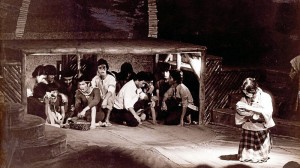I first became aware of Gloria when she joined the tilt (put up by Stella Marquez-Araneta, the first Miss International) that chose our representatives to international beauty pageants.
My sister, Lingling, was then handling the annual contest for Ms Araneta. She asked me if I knew of a pretty coed who could enter the contest. I had earlier recommended Vida Doria, who was chosen Miss Photogenic in an international beauty contest, so she trusted my taste. I recommended Nelia Sancho, who was first runner-up to Gloria and Binky Montinola.
Coveted crown
I met Gloria again years after she won the coveted crown and was ready to enter the movies. When we were to stage “Paglipas Ng Dilim,” I thought the seditious message of the play about Andres Bonifacio and Oryang de Jesus would be “camouflaged” by the sexy presence of the “Pinakamaganda Hayop sa Balat ng Lupa.”
I asked her to appear with a student cast made up of UP Repertory members. For the role of Bonifacio, I approached the late Johnny Delgado (whose real family name is Feleo), the grandson of a revolutionary, Juan Feleo. He alternated with a student, Dennis Asencio.
Gloria alternated with Fe Ramos and Emma Valeros Cruz in the role of the young Oryang de Jesus, Bonifacio’s widow. Also in the cast were Menggie Cobarrubias, Raul Dealino, Madeleine Nicolas and Bienvenido Lumbera.
There are many memories of Gloria’s participation in the play. As an actress, the beauty queen was hardworking and disciplined. However, during one rehearsal, I was surprised when I caught her suppressing giggles during a scene where she was arrested by the guardia sibil.
I demanded to know why. She quietly explained that the student actor who was supposed to frisk her—my statement against martial law—had very cold hands!
We went out often. I became familiar with Gloria’s large family, including her only brother, Ramon. I worked with her again in 1978 after I was released from Camp Bicutan, where she visited me.
Gloria next appeared in Bonifacio Ilagan’s “Sigaw Ng Bayan,” which was tamely retitled “Katipunan.”
Parade
We have remained friends over the years. In fact, when I was residing in the States and was in charge of the cultural committee of a Philippine Independence parade, I asked Gloria if she could participate in it. Joining her in the carroza was her young daughter, now the tall and very beautiful Isabella.
Gloria is one of the few people who calls me Bentot—in public! I have yet to properly retort, but because she has been a steadfast friend in good times and bad, she remains the “Pinakamagandang Hayop sa Balat ng Lupa” in my heart of hearts.
